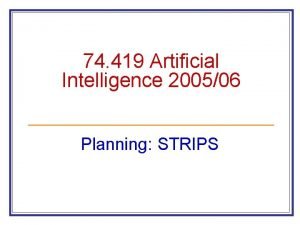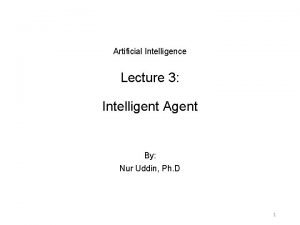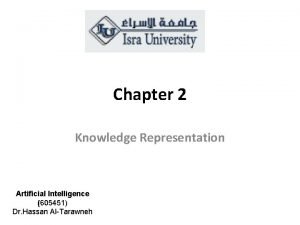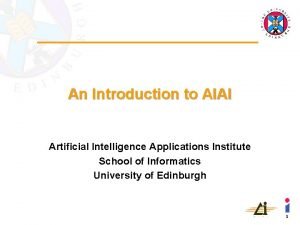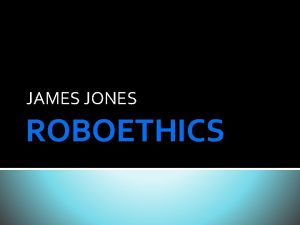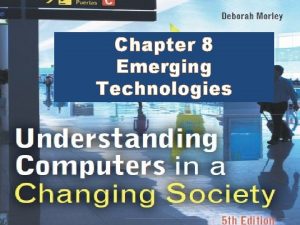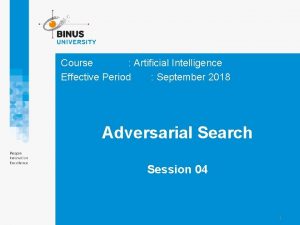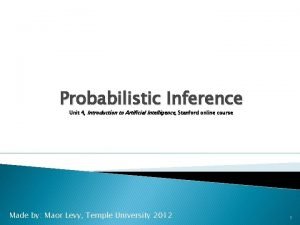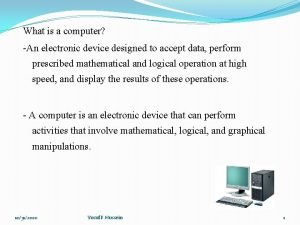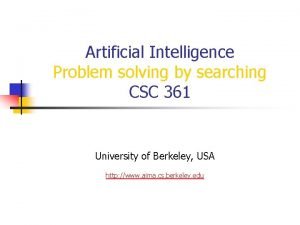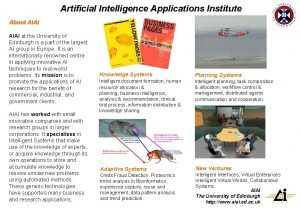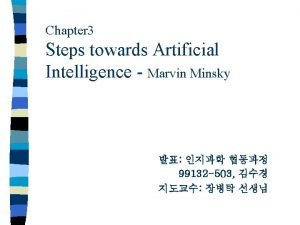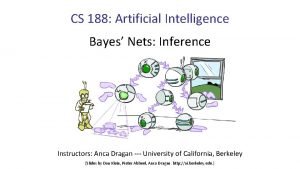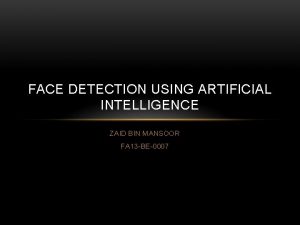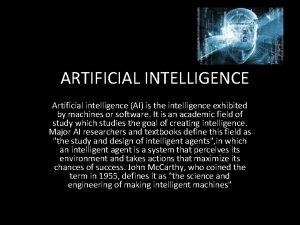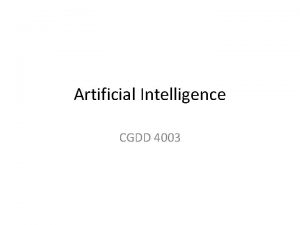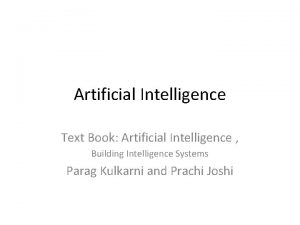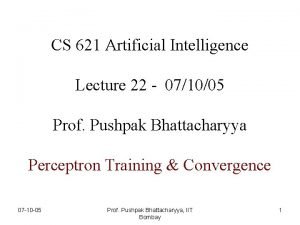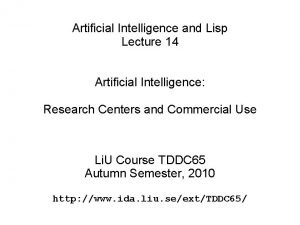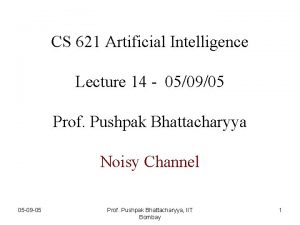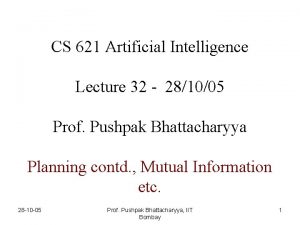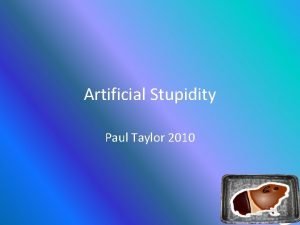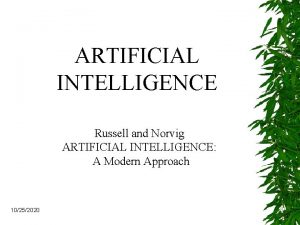Artificial Intelligence Lecture 2 Foundation of Artificial Intelligence























- Slides: 23

Artificial Intelligence Lecture 2: Foundation of Artificial Intelligence By: Nur Uddin, Ph. D 1

What is AI ? 2

Artificial Intelligence (AI) • The name of AI was coined in 1956 • AI attempts to: • to understand how we think • to build intelligent entities 3

Definition of AI 4

Acting Humanly: The Turing Test Approach • The Turing Test, proposed by Alan Turing (1950) was designed to provide a satisfactory operational definition of intelligence. A computer passes the test if a human interrogator, after posing some written questions, cannot tell whether the written responses come from a person or from a computer. A computer needs to possess: • natural language processing to enable it to communicate successfully in English • knowledge representation to store what it knows or hears; • automated reasoning to use the stored information to answer questions and to draw new conclusions; • machine learning to adapt to new circumstances and to detect and extrapolate patterns. 5

Thinking humanly: The cognitive modeling approach (cont’d) • Allen Newell and Herbert Simon, who developed GPS, the “General Problem Solver” (Newell and Simon, 1961), were not content merely to have their program solve problems correctly. They were more concerned with comparing the trace of its reasoning steps to traces of human subjects solving the same problems. • The interdisciplinary field of cognitive science brings together computer models from AI and experimental techniques from psychology to construct precise and testable theories of the human mind. 6

Thinking humanly: The cognitive modeling approach • If we are going to say that a given program thinks like a human, we must have some way of determining how humans think. • Human minds works in following ways: • introspection—trying to catch our own thoughts as they go by; • psychological experiments—observing a person in action; • brain imaging—observing the brain in action 7

Thinking rationally: The “laws of thought” approach • The Greek philosopher Aristotle was one of the first to attempt to codify “right thinking, ” that is, irrefutable reasoning processes. His syllogisms provided patterns for argument structures that always yielded correct conclusions when given correct premises. • For example, “Socrates is a man; all men are mortal; therefore, Socrates is mortal. ” • These laws of thought were supposed to govern the operation of the mind; their study initiated the field called logic. • The so-called logicist tradition within artificial intelligence hopes to build on such programs to create intelligent systems. 8

Thinking rationally: The “laws of thought” approach (cont’d) • There are two main obstacles to this approach: • it is not easy to take informal knowledge and state it in the formal terms required by logical notation, particularly when the knowledge is less than 100% certain. • there is a big difference between solving a problem “in principle” and solving it in practice. 9

Acting rationally: The rational agent approach • An agent is just something that acts (agent comes from the Latin agere, to do). • Computer agents are expected to do: • • • operate autonomously, perceive their environment, persist over a prolonged time period, adapt to change, create and pursue goals. • A rational agent is one that acts so as to achieve the best outcome or, when there is uncertainty, the best expected outcome. 10

Acting rationally: The rational agent approach (cont’d) • In the “laws of thought” approach to AI, the emphasis was on correct inferences (conclusions). • Making correct inferences is sometimes part of being a rational agent, because one way to act rationally is to reason logically to the conclusion that a given action will achieve one’s goals and then to act on that conclusion. • On the other hand, correct inference is not all of rationality; in some situations, there is no provably correct thing to do, but something must still be done. • There also ways of acting rationally that cannot be said to involve inference. 11

Acting rationally: The rational agent approach (cont’d) • All the skills needed for the Turing Test also allow an agent to act rationally. Knowledge representation and reasoning enable agents to reach good decisions. • The rational-agent approach has two advantages over the other approaches: • It is more general than the “laws of thought” approach because correct inference is just one of several possible mechanisms for achieving rationality. • It is more amenable to scientific development than are approaches based on human behavior or human thought. This study therefore concentrates on general principles of rational agents and on components for constructing them. 12

Foundation of AI 13

Foundation of AI The disciplines that contributed ideas, viewpoints, and techniques to AI, as follows: • • Philosophy Mathematics Economics Neuroscience Psychology Computer engineering Control theory and cybernetics Linguistics 14

Foundation of AI: Philosophy • Can formal rules be used to draw valid conclusions? • How does the mind arise from a physical brain? • Where does knowledge come from? • How does knowledge lead to action? 15

Foundation of AI: Mathematics • What are the formal rules to draw valid conclusions? • What can be computed? • How do we reason with uncertain information? 16

Foundation of AI: Economics • How should we make decisions so as to maximize payoff? • How should we do this when others may not go along? • How should we do this when the payoff may be far in the future? 17

Foundation of AI: Neuroscience • How do brains process information? 18

Foundation of AI: Psychology How do humans and animals think and act? • Behaviorism • Cognitive psychology 19

Foundation of AI: Computer Engineering • How can we build an efficient computer? • For artificial intelligence to succeed, we need two things: • intelligence • artifact. • The computer is the artifact of choice. 20

Foundation of AI: Control Theory and Cybernetics • How can artifacts operate under their own control? 21

Foundation of AI: Linguistics • How does language relate to thought? • Modern linguistics and AI: • computational linguistics or natural language processing • knowledge representation 22

The State of the Art What can AI do today? • • • Robotic vehicles Speech recognition Autonomous planning and scheduling Game playing Spam fighting Logistics planning Robotics Machine Translation Etc. . 23
 01:640:244 lecture notes - lecture 15: plat, idah, farad
01:640:244 lecture notes - lecture 15: plat, idah, farad Foundation engineering lecture notes
Foundation engineering lecture notes Raft foundation vs pad foundation
Raft foundation vs pad foundation Composition of urine
Composition of urine Strips planning
Strips planning Omniscience in artificial intelligence
Omniscience in artificial intelligence Xcon expert system
Xcon expert system Analogizers
Analogizers Conceptual graph in artificial intelligence tutorial
Conceptual graph in artificial intelligence tutorial References for artificial intelligence
References for artificial intelligence Artificial intelligence applications institute
Artificial intelligence applications institute Ethics of artificial intelligence
Ethics of artificial intelligence 8 emerging technologies
8 emerging technologies Optimal decisions in games in artificial intelligence
Optimal decisions in games in artificial intelligence Ao* algorithm example
Ao* algorithm example Knowledge manipulation in artificial intelligence
Knowledge manipulation in artificial intelligence Inference by enumeration in artificial intelligence
Inference by enumeration in artificial intelligence Electronic device designed to accept data
Electronic device designed to accept data Informed and uninformed search
Informed and uninformed search Problem solving by searching in artificial intelligence
Problem solving by searching in artificial intelligence Artificial intelligence applications institute
Artificial intelligence applications institute Steps toward artificial intelligence
Steps toward artificial intelligence Inference by enumeration in artificial intelligence
Inference by enumeration in artificial intelligence Conclusion of artificial intelligence
Conclusion of artificial intelligence




